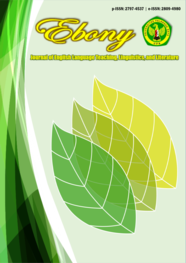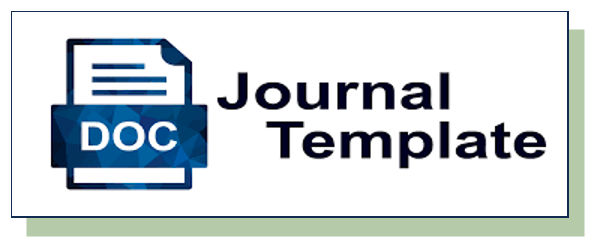The Rhetorical Moves in Indonesian EFL Graduate Students’ Thesis Abstracts
DOI:
https://doi.org/10.37304/ebony.v2i1.4043Keywords:
rhetoric, moves-steps, thesis abstractsAbstract
Rhetoric in an abstract writing literally means the techniques a writer might use to deliver complicated information in a limited amount of space effectively and intentionally. However, as being non-native speaking (NNS) writers, Indonesian EFL Graduate students often have difficulties in producing, organizing, and delivering ideas of an abstract into widely accepted international standard of English academic writing conventions. This study describes the nature and characteristics of the rhetoric of thesis abstract focusing on the moves-step(s) written by Indonesian EFL Graduate Students of Palangka Raya University. The model proposed by Samraj (2002) consisting of five moves: Move 1– Situating the Research, Move 2–Purpose, Move 3–Methods, Move 4–Results, and Move 5–Conclusion was used as a general guideline to analyze the moves-step(s) of the abstracts. The findings of the study show that three textual spaces: M2-Purpose, M3-Methods, and M4-Results are compulsory while the other two (M1-Situating the Research and M5-Conclusion) are optional; and the rhetorical pattern mostly employed in the abstracts is PMRC or M2-M3-M4-M5. However, in realizing the rhetorical strategies of the abstracts, a great deal of first language rhetorical interference (such as redundancy use of steps particularly in M2, reordering or non-linear patterns of steps mostly the steps in M3, the overlap function between moves especially between M4 and M5, the low occurrence of M1, and the repeated use of embedding moves particularly the embedment of M2 and M3) is discovered among the moves or the steps forming each move.
Downloads
References
Anderson, K., & Maclean, J. 1997. A Genre Analysis Study of 80 Medical Abstracts. Edinburgh Working Papers in Applied Linguistics, 8: 1-23.
Basthomi, Y. 2006a. The Rhetoric of Research Article Introductions Written in English by Indonesians. Doctoral Dissertation: Malang: State University of Malang.
Basthomi, Y. 2006b. The Rhetoric of Article Abstracts: A Sweep through the Literature and a Preliminary Study. Bahasa dan Seni, 34(2): 174-189.
Basthomi, Y. 2007. Contrastive Rhetoric, Discourse, and Genre Analysis: Methodological Issues. Bahasa dan Seni, 35(2): 133-146.
Basthomi, Y. 2008. Acknowledging as/Is Respecting: Interlanguage Discourse of Thesis Acknowledgements Section. Paper presented at The 2008 LSP Conference and General Meeting on World Englishes and Second Language Teaching and Learning, the University of Sto. Tomas, Manila, 28-30 April 2008.
Bhatia, V.1993. Analyzing Genre: Language Use in Professional Settings. London: Longman.
Connor, U. 1996. Contrastive Rhetoric: Cross-Cultural Aspects of Second-Language Writing. Cambridge: Cambridge University Press.
Djuwari. 2009. The Genre Analysis of International Conference Paper Abstracts. Unpublished Doctoral Dissertation. Malang: State University of Malang.
Dong, Hai-lin. & Xue, Huan. 2010. Generic Structure of Research Article Abstracts. Cross-Cultural Communication Journal, 6(3): 36-44.
Dudley-Evans, T. 1987. Introduction to Genre Analysis and ESP. ELR Journal, 1: 1-9. Birmingham: University of Birmingham, English Language Research.
Flowerdew, J. 2002. Academic Discourse. United Kingdom: Routledge.
Graetz, N. 1985. Teaching EFL Students to Extract Structural Information from Abstracts. In Ulign J. M and Pugh A. K. (eds) Reading for Professional Purposes: Methods and Materials in Teaching Languages, Leuven: Acco:123 – 135.
Holmes, R. 1997. Genre Analysis and the Social Sciences: An Investigation of the Structure of Research Article Discussion Sections in Three Disciplines. English for Specific Purposes, 16(4): 321-337.
Hyland, K. 2000. Disciplinary Discourses: Social Interactions in Academic Writing. London, UK: Longman.
Hyland, K. 2002. Options of Identity in Academic Writing. ELT Journal, 56(4): 351-358.
Kaplan, R. B. 1966. Cultural Thought Patterns in Intercultural Education. Language Learning, 16, 1-20. http://dx.doi.org/10.1111/j.1467-1770.1966.tb00804.x
Kaplan, R. B. 1967. Contrastive Rhetoric and the Teaching of Composition. TESOL Quarterly, 1, 10-16.
Kaplan, R. B. 1972. The Anatomy of Rhetoric: Prolegomena to a Functional Theory of Rhetoric. Philadelphia: Center for Curriculum Development.
Kaplan, R.B. 1987. Cultural Thought Patterns Revisited. In Writing across Languages: Analysis of L2 Text, Edited by U Connor and R.B. Kaplan, 9-21 Reading, MA: Addison-Wesley.
Martin, P. M. 2003. A Genre Analysis of English and Spanish Research Paper Abstracts in Experimental Social Sciences. English for Specific Purposes, 22(1): 25-43.
Melander, B., Swales, J. M., & Fredrickson, K. M. 1997. Journal Abstracts from Three Academic Fields in the United States and Sweden: National or Disciplinary Proclivities? In A. Duszak (Ed.), Intellectual Styles and Cross-Cultural Communication. Berlin: Mouton De Gruyter.
Pho, P. D. 2008. Research Article Abstracts in Applied Linguistics and Educational Technology: A Study of Linguistic Realizations of Rhetorical Structure and Authorial Stance. Discourse Studies, 10(2): 231-250.
Salager-Meyer, F. 1990. Discoursal Flaws in Medical English Abstracts: A genre Analysis per Research and Text-type. Text, 10(4): 365-384.
Salager-Meyer, F. 1992. A Text-type and Move Analysis Study of Verb Tense and Modality Distribution in Medical English Abstracts. English for Specific Purposes, 11(2): 93-113.
Samraj, B. 2002. Introductions in Research Articles: Variations across Disciplines. English for Specific Purposes, 2: 1-17.
Samraj, B. 2005. An Exploration of a Genre Set: Research Article Abstracts and Introductions in Two Disciplines. English for Specific Purposes, 24(2): 141–156.
Samra, B. 2008. A Discourse Analysis of Master’s Theses across Disciplines with a Focus on Introduction. Journal of English for Academic Purposes, 7, 55-67.
Samraj, B. 2009. Move Structure. Manuscript Submitted for Publication.
Swales, J. 1981. Aspects of Article Introductions. Birmingham, England: Language Studies Unit, the University of Aston.
Swales, J. M. 1990. Genre Analysis: English in Academic and Research Settings. Cambridge, UK: Cambridge University Press.
Swales, J. M. 2004. Research Genres: Explorations and Applications. Cambridge, UK: Cambridge University Press.
Swales, J. M., & Feak, C. B. 2009. Abstracts and the Writing of Abstracts. Ann Arbor, MI: University of Michigan Press.
Van Bonn, S., & Swales, J.M. 2007. English and French Journal Abstracts in the Language Sciences: Three Exploratory Studies. Journal of English for Academic Purpose, 6(2): 93-108.
Wahab, A. 1986. Javanese Metaphors in Discourse Analysis. Unpublished Ph.D. Dissertation. Champaign-Urbana: University of Illinois.
Zeng, Ya-jun. 2009. CARS Model in Analyzing the Introduction of Research Articles: An Example from the Field of Sports Science and Medicine. US-China Foreign Language, 7(3): Serial No 66.
Downloads
Published
How to Cite
Issue
Section
License

This work is licensed under a Creative Commons Attribution-NonCommercial 4.0 International License.











